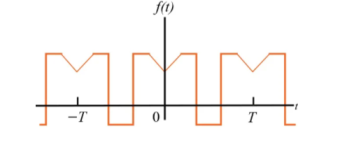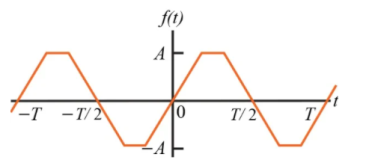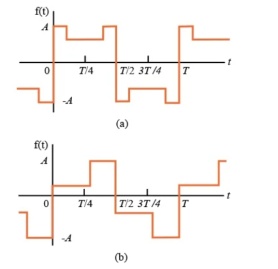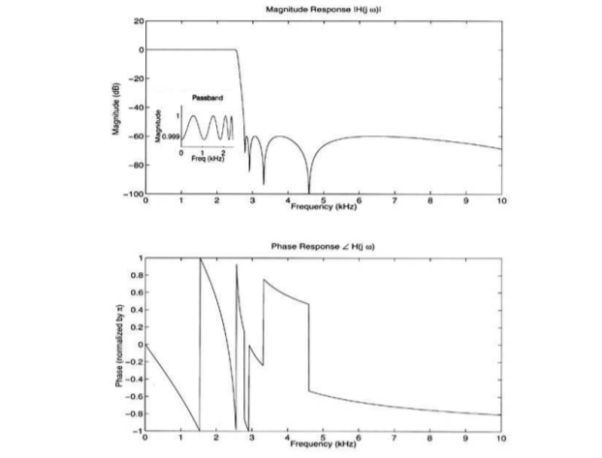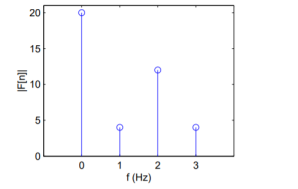 e jkwot ……………………………………………….(2) =
e jkwot ……………………………………………….(2) = k ejkwot where ak= Fourier coefficient = coefficient of approximation.This signal x(t) is also periodic with period T.Equation 2 represents Fourier series representation of periodic signal x(t).The term k = 0 is constant.The term k=±1 having fundamental frequency ω0, is called as 1st harmonics.The term k=±2 having fundamental frequency 2ω0, is called as 2nd harmonics, and so on...The term k=±n having fundamental frequency nω0, is called as nth harmonics. Q2) Write a short note on waveform symmetries?A2)
k ejkwot where ak= Fourier coefficient = coefficient of approximation.This signal x(t) is also periodic with period T.Equation 2 represents Fourier series representation of periodic signal x(t).The term k = 0 is constant.The term k=±1 having fundamental frequency ω0, is called as 1st harmonics.The term k=±2 having fundamental frequency 2ω0, is called as 2nd harmonics, and so on...The term k=±n having fundamental frequency nω0, is called as nth harmonics. Q2) Write a short note on waveform symmetries?A2) dt ---------------------------------------------------(2) ak = 4/T
dt ---------------------------------------------------(2) ak = 4/T  coskwot dt --------------------------------------------(3) bk=0 for all k --------------------------------------------------(4) In eq(4) all b co-effecients are zero if the function is even. The figure depicts the even periodic function.
coskwot dt --------------------------------------------(3) bk=0 for all k --------------------------------------------------(4) In eq(4) all b co-effecients are zero if the function is even. The figure depicts the even periodic function.
|
av = 1/T
= 1/T
|
 sinkwo dt ---------------------------------(2)
sinkwo dt ---------------------------------(2)
|
|
|
 e jkwot ------------------------(1)Multiply e-jnwot on both sides we get x(t) e -jnwot =
e jkwot ------------------------(1)Multiply e-jnwot on both sides we get x(t) e -jnwot =  e jkwot . e- jnwot Consider integral on both sides we get
e jkwot . e- jnwot Consider integral on both sides we get  e jkwot dt =
e jkwot dt =  e jkwot . e- jnwot =
e jkwot . e- jnwot =  e j(k-n)wot dt =
e j(k-n)wot dt =  e jkwot dt =
e jkwot dt = 
 j(k-n)wot dt --------------------------(2)By Eulers formula
j(k-n)wot dt --------------------------(2)By Eulers formula  j(k-n)wot dt =
j(k-n)wot dt =  wo dt + j
wo dt + j  wo dt
wo dt  j(k-n)wot dt = { T k=n0 k
j(k-n)wot dt = { T k=n0 k  nHence in equation(2) the integral is zero for all values of k except at k=n. Put k=n is equation 2 =
nHence in equation(2) the integral is zero for all values of k except at k=n. Put k=n is equation 2 =  j(k-n)wot dt = anT=an = 1/T
j(k-n)wot dt = anT=an = 1/T  -jnwot Replace n by k we get = ak = 1/T
-jnwot Replace n by k we get = ak = 1/T  -jkwot dt x(t) =
-jkwot dt x(t) = e j(k-n) wot where ak = 1/T
e j(k-n) wot where ak = 1/T  -jkwot dt Q4) Derive Fourier Transform?A4) The (CT) Fourier transform (or spectrum) of x(t) isX(jw) =
-jkwot dt Q4) Derive Fourier Transform?A4) The (CT) Fourier transform (or spectrum) of x(t) isX(jw) =  e -jwt dt ---------------------------------------(1)x(t) can be reconstructed from its spectrum using the inverse Fourier transform x(t) = 1/ 2 π
e -jwt dt ---------------------------------------(1)x(t) can be reconstructed from its spectrum using the inverse Fourier transform x(t) = 1/ 2 π  e jwt dw ------------------------------------------(2) The above two equations are referred as Fourier transform pair with the first one being the analysis equation and the second being the synthesis equation. Notation X(jw) = F{x(t)}x(t) = F -1 {X(jw)}x(t) and X(jw) form a Fourier transform pair denoted by
e jwt dw ------------------------------------------(2) The above two equations are referred as Fourier transform pair with the first one being the analysis equation and the second being the synthesis equation. Notation X(jw) = F{x(t)}x(t) = F -1 {X(jw)}x(t) and X(jw) form a Fourier transform pair denoted by  x(t) F X(jw) Q5) Explain convolution?A5) Imagine we have a function f[t] whose Fourier transform is F[w] and another function g[t] whose transform is G[w]. Then the convolution is f[t] * g[t] =
x(t) F X(jw) Q5) Explain convolution?A5) Imagine we have a function f[t] whose Fourier transform is F[w] and another function g[t] whose transform is G[w]. Then the convolution is f[t] * g[t] =  g[t-u] du We write g[t-u] in terms of Inverse Fourier transform g[t-u] = 1/2π
g[t-u] du We write g[t-u] in terms of Inverse Fourier transform g[t-u] = 1/2π  E Iw(t-u) dw dwThus f[t] * g[t] =
E Iw(t-u) dw dwThus f[t] * g[t] =  1/2π
1/2π  E Iw(t-u) dw dw du = 1/2π
E Iw(t-u) dw dw du = 1/2π  E Iwt
E Iwt  E -Iwu du dw But the right hand integral above is the Fourier transform of f[u] so f[t] * g[t] = 1/2π
E -Iwu du dw But the right hand integral above is the Fourier transform of f[u] so f[t] * g[t] = 1/2π  G[w] E -Iwu dw The convolution property states that: x(t) * h(t) > X(w) H(w)Let y(t) =
G[w] E -Iwu dw The convolution property states that: x(t) * h(t) > X(w) H(w)Let y(t) =  h(t-τ) dτ = x(t) * h(t)Y(w) =
h(t-τ) dτ = x(t) * h(t)Y(w) =  e -jwt dt =
e -jwt dt =  h(t-τ) dτ e -jwt dt If we switch the order of the two integrals we get Y(w) =
h(t-τ) dτ e -jwt dt If we switch the order of the two integrals we get Y(w) =  e -jwt dt =
e -jwt dt = 
 h(t-τ) dτ e -jwt dt let u=t-τ=
h(t-τ) dτ e -jwt dt let u=t-τ= 
 h(u) e -jw(u+τ) du dτ =
h(u) e -jw(u+τ) du dτ =  e -jwτ dτ
e -jwτ dτ  h(u) e -jwu du = X(w) H(w)Therefore, y(t) = x(t) * h(t) <-> Y(w) = X(w) H(w)Fourier Transform of the convolution of two functions is simply the product of the Fourier Transforms of the functions. Q6) Explain the magnitude and phase response?A6) H(e jw) = H R ( e jw) + j H I ( e jw) = | H ( e jw) | e j
h(u) e -jwu du = X(w) H(w)Therefore, y(t) = x(t) * h(t) <-> Y(w) = X(w) H(w)Fourier Transform of the convolution of two functions is simply the product of the Fourier Transforms of the functions. Q6) Explain the magnitude and phase response?A6) H(e jw) = H R ( e jw) + j H I ( e jw) = | H ( e jw) | e j  1 (w)
1 (w) 1 (w) = angle H(e jw) Example:h[n] = - δ[n] | H (ejw)| = 1 angle H(e jw) = πIn the magnitude or phase representation a real valued frequency response does not mean that the system is zero-phase. Using this representation,|Y (e jw) | = | H ( ejw)| | X (ejw)|
1 (w) = angle H(e jw) Example:h[n] = - δ[n] | H (ejw)| = 1 angle H(e jw) = πIn the magnitude or phase representation a real valued frequency response does not mean that the system is zero-phase. Using this representation,|Y (e jw) | = | H ( ejw)| | X (ejw)|
|
|
 e-jwn ---------------(1)Here X(w) is a complex function of real frequency variable w and can be written as X(w) = Xre (w) + j X img(w)where Xre (w) , j X img(w) are real and Imaginary parts of X(w)Xre(w) = |X(w)| cos
e-jwn ---------------(1)Here X(w) is a complex function of real frequency variable w and can be written as X(w) = Xre (w) + j X img(w)where Xre (w) , j X img(w) are real and Imaginary parts of X(w)Xre(w) = |X(w)| cos  (w)Ximg(w) = |X(w)| sin
(w)Ximg(w) = |X(w)| sin  (w)|X(w)| 2 = |Xre(w)| 2 + |Xim(w)| 2And | X(w)| can be represented asX(w) = |X(w)| e j
(w)|X(w)| 2 = |Xre(w)| 2 + |Xim(w)| 2And | X(w)| can be represented asX(w) = |X(w)| e j (w)Inverse Discrete Fourier Transform is given by x(n) = 1/2π
(w)Inverse Discrete Fourier Transform is given by x(n) = 1/2π  e jwn dw Q8) Find the DFT of the sequence f(n) ={ 8,4,8,0}A8) F[n] =
e jwn dw Q8) Find the DFT of the sequence f(n) ={ 8,4,8,0}A8) F[n] =  e -j π/2 nk =
e -j π/2 nk =  (-j) nk
(-j) nk
|
1/T
= 1/T
= 0 n≠ m
= If x1(t) = x2(t) = x(t) then eq(3) becomes 1/T
The above equation can be written as
n≠0
= c0 2 + n≠0 a0 2 +
= a0 2 +
|
 j represented by o.Poles z= 7/8 , z=-1/2 represented by x.
j represented by o.Poles z= 7/8 , z=-1/2 represented by x.
Poles and Zeros
|
